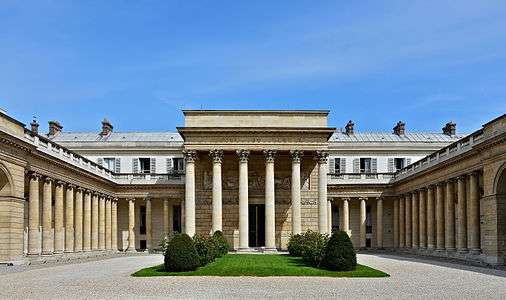Palais de la Légion d'Honneur


The Palais de la Légion d'Honneur (French for "Palace of the Legion of Honour") is a building on the left bank of the River Seine in Paris. It houses the Musée national de la Légion d'Honneur et des Ordres de Chevalerie ("National Museum of the Legion of Honour and its Orders of Knighthood") and is the seat of the Légion d'honneur, the highest order of chivalry of France. The building is also known as the Hôtel de Salm. It is located at 64, Rue de Lille, next to the old Orsay railway station (now the Musée d'Orsay) in the 7th arrondissement of Paris.
History


The Hôtel de Salm was constructed between 1782 and 1787 by the architect Pierre Rousseau (1751–1810) for the German Prince Frederick III, Prince of Salm-Kyrburg. The revolutionary government nationalised the building, and from 13 May 1804 it was renamed the Palais de la Légion d'Honneur, and became the seat of the newly created Légion d'honneur.[1] The interior was remodeled for that purpose by Antoine-François Peyre,[1] and new exterior sculptures were added by Jean Guillaume Moitte and Philippe-Laurent Roland. An additional building was added in 1866 along the then-new Rue de Solférino, but the palace was destroyed by fire in 1871, under the Paris Commune. A replica was rebuilt soon afterwards under Anastase Mortier, with painters Jean-Paul Laurens and Théodore Maillot providing interior decoration. An additional building was added from 1922–1925 on Rue de Bellechasse in order to house a museum of the Legion of Honour.[1]
Influences
The California Palace of the Legion of Honor, a three-quarter scale replica of the Palace, was constructed in San Francisco in 1924; it houses a fine arts museum. In Rochefort-en-Yvelines (near Paris) there is an almost exact replica of the Hotel de Salm, built for the wealthy banker Jules Porgès by the architect Charles Mewès, and called the Chateau de Rochefort en Yvelines; today it is a golf club. In Haarlem in the Netherlands the banker Henry Hope had his resembling Villa Welgelegen. It was also a favorite of Thomas Jefferson, who singled it out as a model for the American public buildings of Washington DC. He had observed its construction during his stay in Paris in 1784–1789, and his design for Monticello, his own estate, was based on it.[2]
References
External links
-
 Media related to Hôtel de Salm at Wikimedia Commons
Media related to Hôtel de Salm at Wikimedia Commons
Coordinates: 48°51′37.33″N 2°19′27.59″E / 48.8603694°N 2.3243306°E